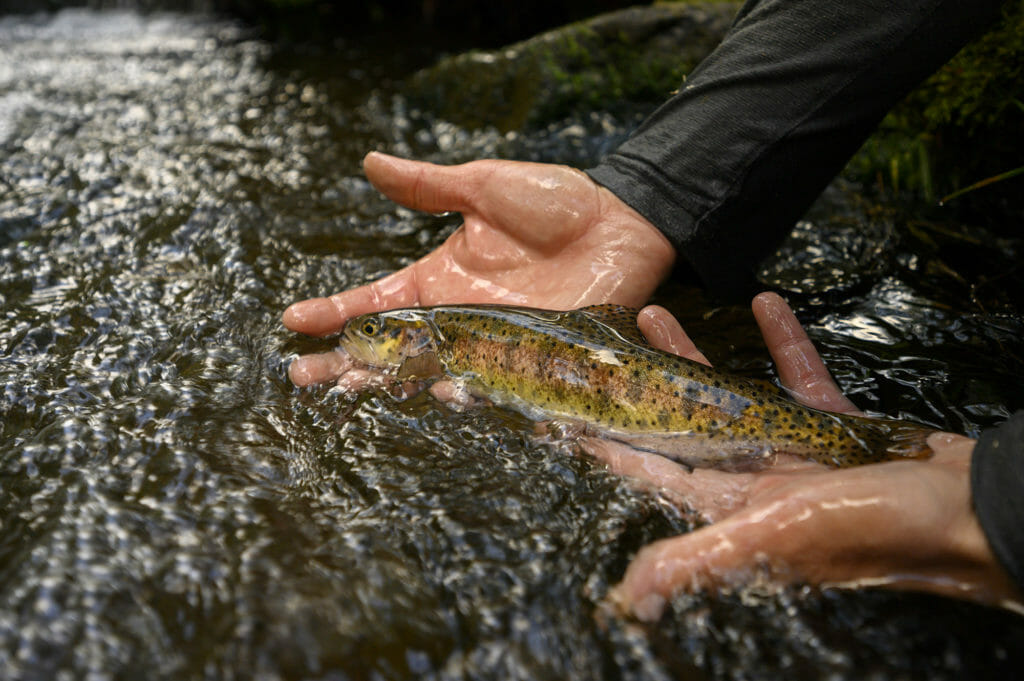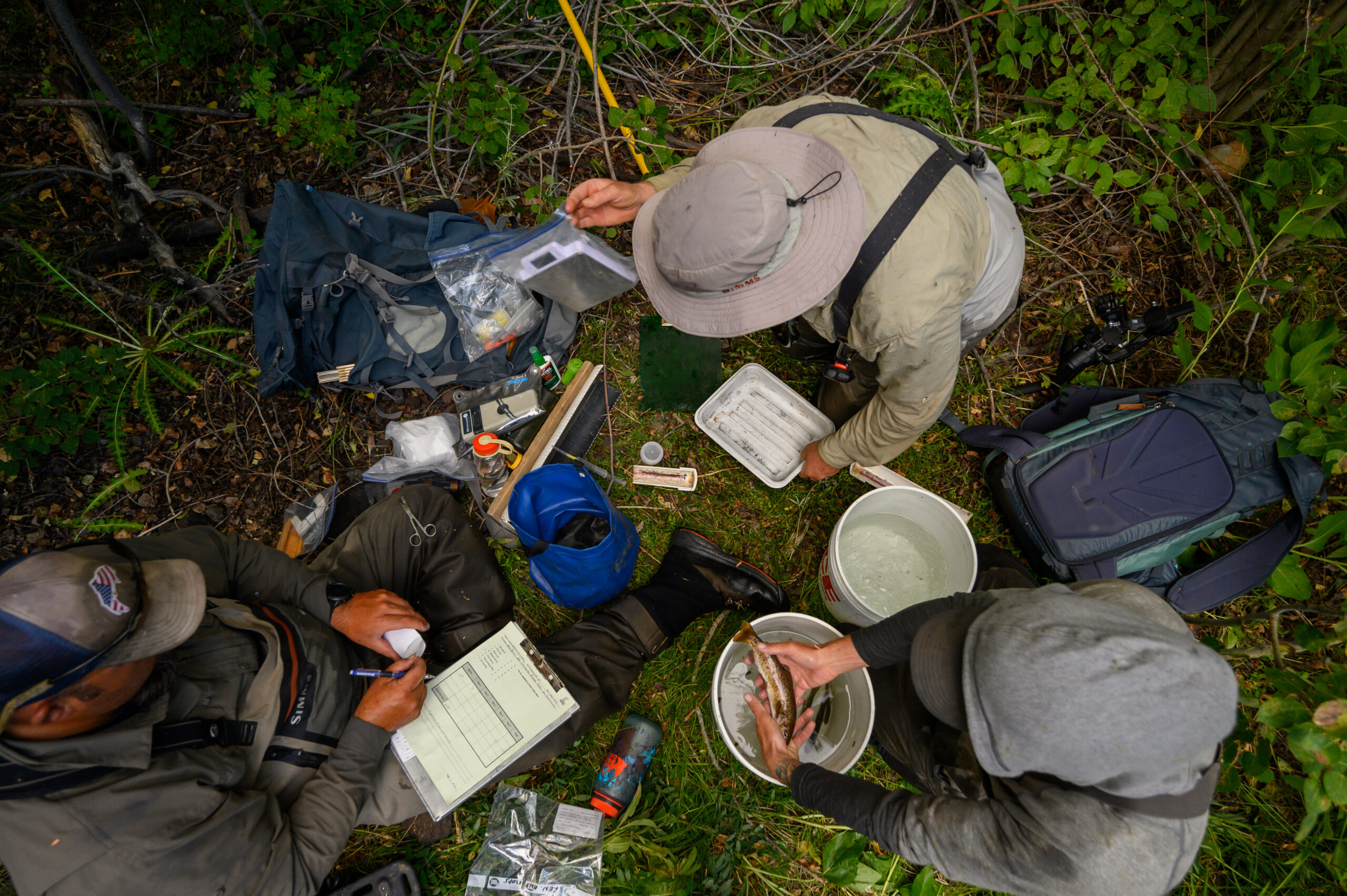
Lately I’ve been ruminating about why I love genetics, a wonky field of numbers and theory where a true understanding of results only happens long after the field season — in an office, on a computer at that. Every time I get new genetic results it’s like receiving a surprise gift.
So many processes — all this history we can’t see — shape the genes of all organisms, including fish. The genetic patterns we uncover, then, tell us real and important things about the conservation needs of these fish.

When we go out to collect samples in the field, something I, unfortunately, rarely do myself these days, we slog miles and miles with an electro-fisher, buckets, nets, measuring boards, and a whole sundry of smaller field equipment. Occasionally, we also carry in everything needed to camp in the wilderness for days on end.
We often get so caught up in the work that we only see the surface of these beautiful places. Sometimes we do smell the dewy sage brush we plow through in the early morning; hear the dance of the water maneuvering the rocky stream substrate; see trout darting to the safety of an undercut bank. That portal into nature is the restorative part, what we know to expect, and truly enjoy about this work.
But once we see the genetic patterns of these fish, a whole new world opens.
All this involves is taking a small, fingernail-clipping sized sample of fin, which we dry in a coin envelope or on special photography paper that fuses fin with fiber. We record the details of where the fish was sampled, its size, and give it an individual ID number.

Back in the lab, the cells from the tissue are processed to extract DNA, which is then replicated millions of times and analyzed in various ways depending on specific questions of interest. It may be many months later that we get to see the results: the genotypes. We can then analyze the genotypes according to various genetic theories, using different genetic modeling programs, to understand the hidden world we seek.
With the whole new field of genomic sequencing we can ask all sorts of complex and amazing of things about evolution and about how fish adapt to their environment.
I have done some of this work along the way, but most of the work I do at TU focuses on understanding the current ‘health’ of populations and what they need in terms of management: information about movement, population size, population stability, and hybridization with non-native trout. Mostly I work on Lahontan cutthroat trout, a listed species now found almost exclusively in small, isolated streams across northern Nevada, southern Oregon, and eastern California.
Way back when (almost two decades ago!) I did my dissertation in Marys River, Nev., one of the only remaining large, interconnected systems available to Lahontan cutthroat trout, but one that also housed several populations isolated from other trout above waterfalls or manmade barriers. I looked at genetic patterns to understand how the fish used their landscape, sampling cutthroat from every tributary stream and multiple places in the mainstem river.

The genetic patterns across individuals told me meaningful stories: stories of lost genetic variability due to isolation from natural or manmade barriers or even from behavior, as some fish in the highest reaches of streams adopt a residency strategy and self-isolate in these headwaters their whole lives. Eventually, no matter the cause, that isolation is reflected in less and less genetic variability, and an increased similarity among individuals in that habitat compared to fish in other streams. In the case of human-isolated streams, this loss of diversity was observed in about 70 years.
Genetic patterns in the mainstem river told a different story, one of genetic mixing from the fluvial migratory life history strategy of the many fish who moved to large mainstem habitats to overwinter and grow; patterns here reflected high genetic variability, a mosaic of genetic diversity from all of the contributing populations throughout the system.

These patterns are important to understand because genetic variability is the key to how populations adapt to a changing environment — if they lose this variability, they have fewer tools in the toolbox to draw from in the future. The patterns painted a picture of why conserving large population strongholds like the Marys River, where migratory strategies can be maintained, is important for maintaining diversity. This work has been used to prompt reconnection efforts for LCT, and we’ve since used these genetic approaches to monitor fish movement after removing man-made barriers and reconnecting tributaries to the mainstem river in Maggie Creek in Nevada.
I am in the final throes of a new study, a genetic assessment of almost all populations across the entire range of Lahontan cutthroat trout. I will be submitting the results for peer-review and publication which means that, based on the critique and input of other scientists, some of the details and interpretations of this story might change slightly. But the basic patterns I am seeing will not.
The story these genetic patterns across the entire range of Lahontan cutthroat trout is telling me is worrisome. It is one of significant hybridization with rainbow trout in at least one priority conservation population, and hints of it in others; one of isolation and lost variability in the majority of populations whose genes whisper their future is at risk.

Often, I don’t like the pictures this genetic information paints for me. As Aldo Leopold said, “One of the penalties of an ecological education is that one lives alone in a world of wounds,” and it’s hard to not to get down about results like these.
But it is crucial information. It’s information that, because of our partnerships with management agencies and tribes, I know will be used to guide future conservation decisions and opportunities for Lahontan cutthroat trout; information that has already prompted a new Trout Unlimited ‘genetic rescue’ study to evaluate the benefit of transferring individuals among streams to restore genetic diversity; information that is important for the future of this fish.
Helen Neville is the senior scientist at Trout Unlimited.



